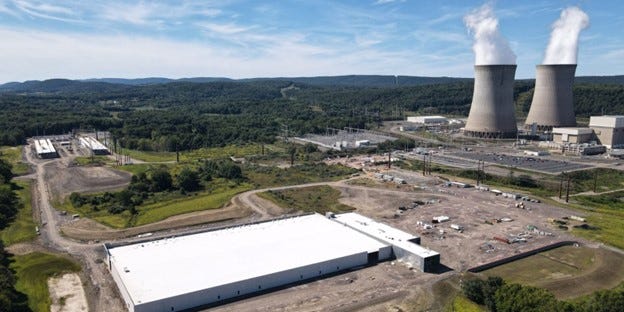AI: Power Plays begin to build Gigawatt AI data centers. RTZ #481
...Ohio regulatory negotiations show what's ahead for big AI tech as 'AI Table Stakes' competition accelerates
I’ve discussed the accelerating ‘AI Table Stakes’ in this AI Tech Wave for the big tech companies, as the underlying AI technologies evolve rapidly to make entirely new AI applications possible. These include the AI Reasoning and Agentic applications I’ve discussed at length, with OpenAI leading the charge last week with its new OpenAI-o1 release.
But the fundamental reality is that there are THREE critical inputs needed to make all this happen:
Massive increases in AI GPU and related hardware/software infrastructure from Nvidia and others,
Tens of billions in new generations of AI data centers that will need trillions in investments, and
Copious amounts of Power and Water (for Cooling), to make it AI happen at True Scale. It’s not just the pick axes and shovels that are needed.
Power plays a HUGE role. And so the power plays are underway to negotiate the best deals for all parties concerned. AI Talent is another critical input of course, a subject for another day.
My second piece on AI Table Stakes a few days ago underlines the complexity and the necessary cooperation across multiple industries to make it happen.
And one of those critical areas of cooperation lies in the Big Tech companies coming to agreements with critical power utilities and regulatory authorities across the country on the prices paid to scale up that Power. And as one might imagine, the negotiations are not going to be easy.
The Washington Post has a detailed piece on this worth reading in its entirety, titled “Tech Giants fight plan to make them pay more for electric grid upgrades”:
“Negotiations between Big Tech and an Ohio power utility could set a national precedent as communities grapple with the energy demands of the data center boom.”
“A regulatory dispute in Ohio may help answer one of the toughest questions hanging over the nation’s power grid: Who will pay for the huge upgrades needed to meet soaring energy demand from the data centers powering the modern internet and artificial intelligence revolution?”
“Google, Amazon, Microsoft and Meta are fighting a proposal by an Ohio power company to significantly increase the upfront energy costs they’ll pay for their data centers, a move the companies dubbed “unfair” and “discriminatory” in documents filed with Ohio’s Public Utility Commission last month. American Electric Power Ohio said in filings that the tariff increase was needed to prevent new infrastructure costs from being passed on to other customers such as households and businesses if the tech industry should fail to follow through on its ambitious, energy-intensive plans.”
“The case could set a national precedent that helps determine whether and how other states force tech firms to be accountable for the costs of their growing energy consumption.”
“Central Ohio, a Rust Belt region that has struggled with the departure of its manufacturing industry, has rapidly emerged as a data center stronghold in the United States. The power company said projected energy demand in central Ohio forced it to stop approving new data center deals there last year while it figured out how to pay for the new transmission lines and additional infrastructure they would require.”
“The energy demands of data centers have created similar concerns in other hot spots such as Northern Virginia, Atlanta and Maricopa County, Ariz., leaving experts concerned that the U.S. power grid may not be capable of dealing with the combined needs of the green energy transition and the computing boom that artificial intelligence companies say is coming.”
And the Federal government is likely to weigh in on the impending regulatory negotiations:
“On Thursday, the White House announced measures intended to speed up data center construction for AI projects, including by accelerating permitting.”
The piece then goes on to lay out the arguments from both sides of the negotiating table, and the ‘big-ask’ spread for the up front payments over meaningful time commitments, by the big tech companies for their new ‘gigawatt’ data centers:
“Energy customers must sometimes make a monthly payment to a utility that is a percentage of the maximum amount of electricity they predict that they could need. In Ohio, data center companies had agreed to pay 60 percent of the projected amount. But in May, the power company proposed a new, 10-year fee structure raising the charges to 90 percent of the expected load, even if they don’t end up using that much.”
It’s important to understand the broader context of the impact of data centers on the electric grids not only in Ohio, but other places around the country with the right mix of power, water, and land:
“Data centers notoriously require a lot of electricity to run the high-powered computers inside and the cooling systems that prevent them from overheating. According to testimony from AEP Ohio Vice President Lisa Kelso, there are 50 pending requests from data center customers seeking electric service at more than 90 sites, a potential 30,000 megawatts of additional load — enough to power more than 20 million households. That additional demand would more than triple the utility’s previous peak load in 2023”.
“Between 2020 and 2024, the data center energy load in central Ohio increased sixfold, from 100 to 600 megawatts, her testimony reads. By 2030, that amount will reach 5,000 megawatts, according to the utility’s signed agreements, she testified. “Central Ohio’s total load will more than double from approximately 4,000 MW to 9,000 MW over the course of a decade,” it continues, “and AEP Ohio’s Top 5 customers will all be data center customers by 2030.”
These are the ‘gigawatt AI data centers’ that Mark Zuckerberg of Meta, Jensen Huang of Nvidia and others have been talking about for months now, as I detailed in the second ‘AI Table Stakes’ piece.
The jostling over the potential terms has already started:
“AEP Ohio’s testimony in the case also questions whether data centers bring as much to local communities as factories or other high-energy-load businesses. Since 2019, non-data center businesses have created approximately 25 jobs for every megawatt of power requested, while data centers have created less than one job per megawatt, according to Kelso’s testimony.”
The tech companies of course have their perspective as well:
“The tech companies rejected this criticism, saying the number of jobs they create is not relevant to how much power they have a right to purchase, and highlighted their other contributions to local economies. Google said it had created more than 1,000 jobs in Ohio in the past year, investing $6.7 billion since 2019. Amazon said its cloud computing division had created more than 4,500 jobs in the state with an investment of $10.3 billion over eight years, and it plans to spend $7.8 billion more in coming years. Meta, meanwhile, said it had spent $1.5 billion on data center projects in the state.”
Ohio is just the beginning. This debate is going on in other states as outlined above. And the options for big tech companies are not as broad and deep as they might like:
“Should the Ohio tariff be approved, Microsoft and Google both threatened in their testimony to leave Ohio. “If AEP Ohio’s proposal is adopted,” wrote Google’s Baatz, “it would create an unfavorable environment for data center development in the state, potentially causing companies to reconsider their investment plans.”
“But while the tech companies can technically take their power-hungry data centers elsewhere, pressure on the electric grid is mounting all over the country, and many communities are already grappling with how to accommodate it, making it incumbent on the Big Tech companies to find a way to work with utilities in Ohio and elsewhere.”
“After all, as Amazon’s Fradette wrote, “Without a reliable source of power, our business would not exist.”
As I’ve said before about AI GPU chips needed in Scale over the next few years from Nvidia, Power and related inputs are also non-negotiable inputs in these early days of the ‘AI Tech Wave’. Without them, ‘AI’ are just two non-adjacent letters in the English language.
These knotty power issues have to be resolved sooner than later for all parties concerned. Especially as China races forward on all these goals with their top down and bottom up way of ‘Finding a Way’. That ‘Threading the Needle’ geopolitical AI ‘Space Race’ is an overarching power play in this discussion of course.
The US has a head start that need to navigate the multiple layers of power plays underway. Up and down the AI Tech Stack below.
It’s all just getting powered up. Stay tuned.
(NOTE: The discussions here are for information purposes only, and not meant as investment advice at any time. Thanks for joining us here)










